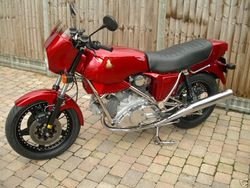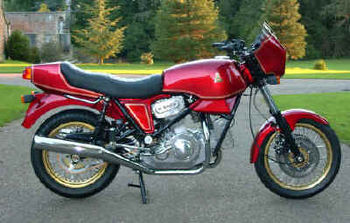Hesketh V1000: history, specs, pictures
 |
|
| Hesketh V 1000 | |
| Manufacturer | |
|---|---|
| Production | 1980 (125 units) |
| Class | Sport touring |
| Engine | Air Cooled, Four Stroke, V-twin, 4 Valve Per Cylinder |
| Compression ratio | 9.5:1 |
| Horsepower | 81.94 HP (61.1 KW) @ 6800RPM |
| Torque | 78.19 ft/lbs (106.0 Nm) @ 5400RPM |
| Fuel System | 2x36mm Dell'Orto Carburetors |
| Transmission | Gear box: 5 Speed Final Drive: Chain |
| Suspension | Front: Marzocchi Telescopic Forks Rear: Marzocchi Air Spring Preload |
| Brakes | Front: 2x280mm Discs Rear: Single 280mm Disc |
| Front Tire | 4.10-V19 |
| Rear Tire | 5.10-V17 |
| Weight | |
| Manuals | Service Manual |
Hesketh was never big. If anything it was pitifully small – only a few hundred V1000s sold worldwide, but the same can’t be said for the bikes themselves. They’re huge. A Hesketh’s dimensions – 550lbs dry weight and 59.5 inches from one wheel spindle to the other – sound imposing, but you have to be side-by-side with one to fully appreciate its scale.
That’s where I find myself, standing next to David Killner’s very tidy 1984 V1000. I’m 6ft tall, yet the top of the seat is almost level with my waist. A shrinking violet it is not. Nor is the man who put his name to this beast. Lord Thomas Alexander Fermor-Hesketh, an eccentric aristocrat with a passion for things fast and mechanical, ploughed his hefty inheritance into designing and building the V1000 in the early Eighties. A more British venture you’d be hard pushed to find.
Hesketh, and the press, built the V1000 up as the bike that would save the British motorcycle industry. Sadly it was destined to fail. David rocks the Hesketh off its main stand, turns both fuel taps to on (it uses one for each cylinder), feeds in a touch of choke and fires the 992cc V-twin into life. Oh, what a sound. The flat rhythmic booms from the Hesketh’s pipes sound like two Brit singles competing for attention. It’s an extraordinary exhaust note and quite unlike an Italian V-twin.
As I lean forward to the bars, the seat’s so wide it splays my legs, losing me two inches in height, so reaching the floor is harder than it would normally be. For anyone smaller it’d be a struggle. One advantage for someone 6ft-plus is long distance comfort. Once settled in, I feel as though I could sit there all day. Some owners do, covering huge mileages in one hit. That’s the Hesketh’s true forte. It’s a grand tourer; the two-wheeled equivalent of a Jag, without the walnut dash and leather trim.
When riding a Hesketh, planning ahead is essential. It’s no good tramping along in the hope that you’ll be able to react to bends, roundabouts and other obstacles in your path. This is not a bike that executes split-second decisions. So I make it my mission to seek out its favoured territory: smooth, winding A-roads. It’s not long before we find our quarry. Time to stretch the V1000’s legs.
I steal a glance at the speedometer. We’re doing 80mph – very comfortably it must be said – at 4200rpm. As I wind on the throttle, in top, the speedo fl ashes its way past a ton. Given enough road she might show 120mph, but I don’t want to rely on the Brembo brakes. They lack power and feel and are simply not up to stopping a bike of this size. New pads, lines and fluid would improve things.
One thing that doesn’t need improving is the ride quality. It’s excellent. Top quality Marzocchi suspension shields the rider from jolts and shakes that might otherwise be brought on by bumps and undulations in the road. Stability, too, is superb.
Away from the fluid rhythm of the A-road the Hesketh requires more input. For every mile of road, we’re faced with at least three bends. The bike’s 19in front wheel and lengthy wheelbase accentuate the heavy steering. And understeer is my unwelcome companion as I exit every corner. The bike’s out of its comfort zone and it’s letting me know.
When the V1000 was launched its notchy gearbox was criticised, but as I snick another ratio on David’s bike I wonder what all the fuss was about. Five hours in and I haven’t missed a gear (this bike is fitted with an EN10 kit – see page 56).
Hesketh’s have long been misunderstood. Sure they had their foibles when launched, but a fully sorted example, like this, is a different proposition altogether. It doesn’t burn any oil, leak any fluid or crunch any gears. And it’s a pleasure to ride.
Hesketh’s intention was to build a high quality British bike. This sorted example at last lives up to that ideal. And that, given the marque’s troubled past, is a very big deal indeed.
1984 Hesketh V1000 Specification[edit | edit source]
Engine/Transmission[edit | edit source]
Type - air-cooled, dohc, 90º four-stroke V-twin Capacity - 992cc Bore x stroke - 95 x 70mm Compression ratio - 9.5:1 Carburation - 2 x 36mm DellOrto Primary/final drive - gear/chain Clutch/gearbox - wet multiplate/five-speed Electrics - 12v, Lucas RITA elec ignition
Chassis[edit | edit source]
Frame - tubular steel open cradle frame Front suspension – Marzocchi telescopic forks Rear suspension - swingarm, twin Marzocchi shocks Brakes front/rear - 2 x 11in discs, 1 x 11in disc, single pot calipers Wheels - Astralite alloy Tyres front/rear - 110/90 19, 130/90 17
Dimensions[edit | edit source]
Dry weight - 550lbs/250kg Wheelbase - 59.5in/1511mm Seat height - 33in/838mm Fuel capacity - 5.06 gals/23 liters
Performance[edit | edit source]
Top speed - 114.2mph * Max power - 82bhp @ 6000rpm * Fuel consumption - 31mpg * Price new - £4495 (1981 V1000)
When Lord Alexander Hesketh announced his intention to build a new prestige motorcycle, it was not simply the fanciful notion of an eccentric millionaire.
He’d already enjoyed a successful – if costly – career in Formula One, with heart-throb-of the-moment James Hunt behind the wheel. After down-sizing his F1 effort in 1975,
Hesketh and business partner Anthony ‘Bubbles’ Horsley decided that the future of the R&D-based Hesketh Motors lay in an all-new British motorcycle.
By 1977 plans were underway for a luxury V-twin, powered by a specially designed Weslake engine. Prototypes built at Hesketh’s premises (converted stables on the family estate at Easton Neston, Northamptonshire) were tested and refined under the eye of ex-BRM and Leyland engineer Geoffrey Johnson.
Hesketh obtained the investment to set up Hesketh Motorcycles PLC at a plant in Daventry, Northants, in 1981. Quality-control equipment, worth £100K, was installed and wall posters cautioned that ‘The Customer is the Final Inspector’, and other inspirational homilies. The V1000 would be expensive but the buyer was assured of the finest quality available. The possibility of racing was hinted at and at last the clouds that had hung over Britain’s motorcycle industry for more than a decade seemed as if they might disperse.
Then came the press launch. Hesketh pulled out all the stops, getting nine-times world champion Mike Hailwood to unveil Blighty’s first all-new motorcycle in more than a decade from underneath a Union Jack cover. After all the excitement and anticipation – initially at least – nobody wanted to be first to say that the bike was a hound. MCN’s headline, ‘Noisy, but it’s a dream handler’, seemed only to damn it with faint praise. Mechanical noise aside, the big problem was the gearbox. Even Hailwood struggled to engage first gear at the launch. Within a year Hesketh spent £590,000 on a gearbox redesign that ultimately drove the firm into receivership.
When the Daventry factory closed in 1982 redundant R&D staff stuck with it, moving back to Easton Neston to continue development. As Hesleydon Ltd (the name was an amalgam of Hesketh, Horsley and Johnson) they bought back parts and tooling from Daventry. After developing an improvement package, codenamed EN10, which cured most of early bikes’ ills (oil leaks, overheating, engine noise and poor lubrication), limited production resumed. Building around two bikes a week, the individual attention finally achieved what no wall-mounted inspiration ever could and after-sales problems were few.
The modest profits funded the design of the fully-faired Vampire, to satisfy apparent demand for a long-distance tourer, but sales were poor and Hesleydon Ltd ceased trading in 1984.
And yet you can still buy a brand new Hesketh – £12–£20,000 and a two-year wait gets you a V1000, a Vampire or the new 1200cc Vulcan. Sales are small but then it’s just a sideline for Broom Development Engineering, run by former Hesketh R&D manager Mick Broom. Since 1984 BDE has continued to evolve a motorcycle whose sternest critics were always forced to admit had potential.
At a glance the new Hesketh appears little changed. For Broom’s customers the enormous media hype before the bike’s launch left an indelible image of how a Hesketh should look.
This is a bike that has been invisibly updated; modern suspension, brakes and engine management keep it abreast of the times, while remaining true to Mockett’s original design.
But what of the Vortan, Broom’s Streetfighter? Is it the future for Hesketh? Probably not. Since the prototype first appeared in 1991 none have been made, but perhaps it has already achieved its goal. It exists, for all Hesketh-lovers but particularly for Broom himself, as living proof of what might have been. Not so much the future, more the present in some parallel universe.
Hesketh – Formula One’s Establishment[edit | edit source]
Extravagant aristocrat Lord Hesketh ploughed his sizable inheritance into Formula One car racing before turning his hand to motorcycle manufacturing. His team, which competed in F1 between 1973-1978, proved to be the perfect spring board for the late, great James Hunt, who drove for them between ’73-’75 before taking the title for McLaren the following year.
Hesketh scored one GP win – Holland ’75 – and came fourth in that year’s constructors’ championship, but the team is perhaps best known for its off-track activities. Parties, butlers and Rolls-Royces were all part of the Hesketh racing package, much to the derision of other teams. But after five years the team ran out of both money and steam.
